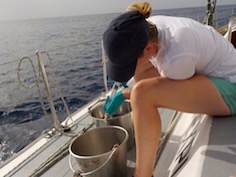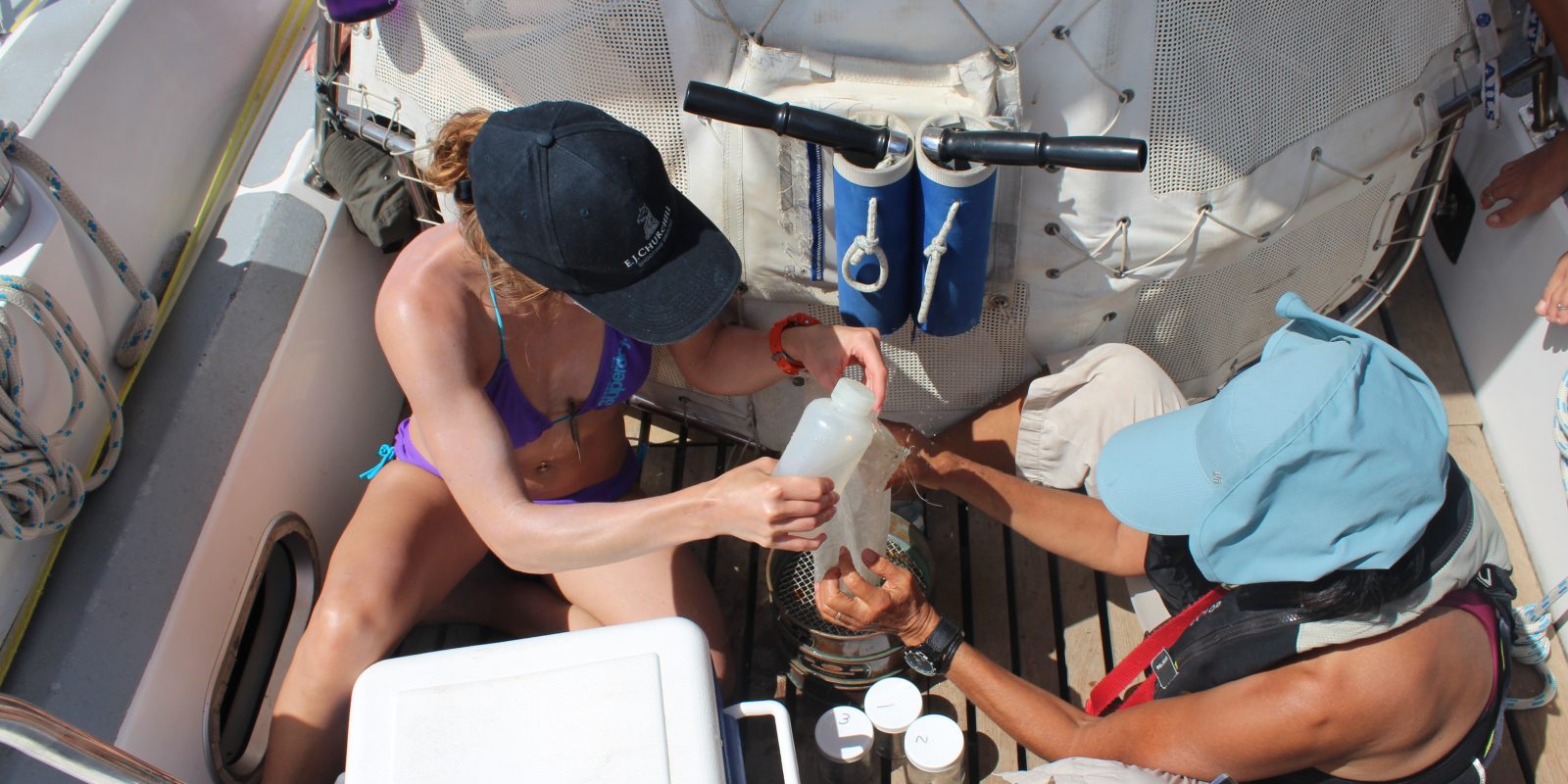We’ve been collecting samples for a little over 10 days now. And although we recognize how unique this opportunity is to collect along a 2000+-mile transect from Africa to South America, there is no sugar-coating the pervasive feeling that the repetitive field sampling we are doing has lost its allure. Even we scientists can appreciate that the long hours under a hot tropical sun constantly trying to maintain position on a pitching sailboat while meticulously filtering liter after liter of sea water through tiny cylindrical cartridges to collect the drops in a steel bucket might get a bit boring after a while. Jan, Tegan and I attempt to inspire the crew to soldier on by telling tales of exciting scientific findings that, unknown to most of the lay public, were brought to light in much the same unglamorous way.
The pay-off for the crew’s labors will come in a few months when back in their laboratories, Jan and Barbara analyze the dozens of filters we prepare containing plankton, microbes, and possibly endocrine disrupting chemicals.
Fortunately, we are encouraged by some instant gratification for our research efforts. Christine tracks the temperature, salinity, and pH levels which is changing slightly as we move west. Our daily deployment of the mantra trawl to ‘fish’ for microplastic (plastic pieces < 5 mm in size) along the surface of this remote part of the Atlantic Ocean has already provided important data points to the global databases tracking marine microplastic. We are averaging 1 piece of microplastic every couple of days. Most of the plastic we find is clear and difficult to distinguish from similarly appearing blobs of invertebrate egg masses.
We confirm it is plastic under a microscope — further laboratory analysis by Jenna Jambeck will tell us what kind of plastic. Sadly, filter-feeding fishes likely consume the plastic right along with the delectable bits they pursue.
Perhaps it is for the best that, in contrast to last year, our trawling nets are coming up with very few organisms. Other than the occasional crustacean, all we are seeing are a handful of baby fish or ichthyoplankton and fish eggs. This part of the ocean seems deserted. We wonder if the seeming lack of food at the bottom of the food chain explains why we are not seeing many dolphins or whales (or mahi mahi on the end of my fishing line!). Could we be passing through a large fish nursery area where the newly hatched baby fish are safe from predators? Lots of questions to pursue when we return to land.
The course we are sailing is hundreds of miles from either of the two large Atlantic garbage patches. It is our mission to determine the density of plastic in this unexplored region outside of these known zones where plastic collects in gyres or circulating currents. As expected, plastic density is low here, but not absent.
In addition to the occasional microplastic, we have observed over 500 pieces of floating plastic debris which we have documented with georeferencing in the Marine Debris app. Among the floating food and beverage containers and wrappers, we have also seen evidence of lost or abandoned fishing nets and floats. This trash is especially worrisome as it can entrap marine mammals and turtles leading to their death. According to the U.S. Marine Mammal Commission’s last published report, 136 marine species have been reported in entanglement incidents, including six species of sea turtles, 51 species of seabirds, and 32 species of marine mammals (Marine Mammal Commission 1999). Of the 120 marine mammal species listed as rare, threatened, or endangered 45% were reported to have interacted (ingestion and/or entanglement) with marine debris.
The importance of our daily tasks, as mundane and routine as they may have become, sinks into our individual and collective consciousness each evening during our after-dinner discussions. These lively talks led by a different crew member each night are energizing. Christine’s dreams of a pollution-finding robot on every hardware store shelf, Sarah’s real-life descriptions of community-level alternatives to our pre-packaged consumer goods, Katie’s poignant challenges with embracing a healthier diet and work life, and many other stories give us pause to reflect, ideas to implement, and ultimately hope to take back to our family, friends and communities. We still have 800 miles to go before Recife, Brazil and more data to collect. Stay tuned as we continue our adventures in science and sailing!
by Diana Papapoulis, Mission leader and Ecotoxicologist


